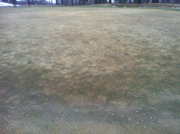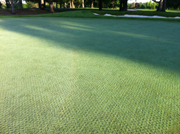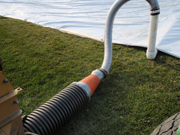
Features
Agronomy
Tarps helped club get the best of devastating winter of 2013-14
March 24, 2015 By Mike Jiggens
The winter of 2013-14 is still being talked about one year later. It was the winter which wreaked havoc on golf courses across southern Ontario whose putting surfaces were grown to poa annua.
Many horror stories have been told, albeit with eventual happy endings. Not all stories have been the same.
Speaking in January at the annual conference of the Ontario Golf Superintendents Association in Niagara Falls, Weston Golf & Country Club superintendent Rob Ackermann told a bit of a different story.
A proponent of covering his greens during the winter season, Ackermann said his strategy helped him get a leg up on several of his colleagues in the region who suffered major setbacks.
He said he had used tarps on his greens during his years as superintendent at Markland Wood Golf & Country Club before making the move to Weston in 2001. At one time, he used clear, impermeable covers on all his greens. There were some individuals at the club who thought the tarps were suffocating the greens and actually contributing to damage, but Ackermann refuted such assumptions, claiming the tarps were consistent and worked extremely well in some years.

Acknowledging that his profession involves continuous learning, adding that he’s always “stumbling” upon one thing or another, he said he has tweaked his use of covers over the years in an effort to find a system which works best for him.
Using clear tarps, for example, in mid-February with no snow cover could produce under cover temperatures of 17.5 degrees Celsius which he said was not favourable. The plant doesn’t know what’s happening and is getting heat when it’s not wanted.
He had tried a white-coloured tarp on his 16th green which is situated in a fully sunlit location, finding the temperature under the cover was more in keeping with the outside temperature. The white colour reflecting the sunlight made a significant difference.

The greens at Weston are a heavy soil makeup. In the past, there was no internal drainage and the presence of trees around the greens proved to be a major issue. Ackermann said he was forced to deal with such issues and their impact on his growing environments.
Each year, he learns more and more about winter issues, and has reached the conclusion that water is more of an issue during the winter than shade, although it’s the other way around in the summer.
“Your biggest concern if you’re growing poa greens is that water.”
To combat against water getting through onto his greens, Ackermann said his covers need to be impermeable, yet they must also be white to avoid a significant heat buildup, especially at the end of winter.
“I can take my sweet time taking those tarps off. I don’t care if there’s four inches of ice on top of those things. I’m in no panic to get it off because the temperature’s not going to rocket.”
The temperature will instead remain steady, he said.

Ackermann said it’s a big task to cover all 18 of his greens. The club recognizes the fact it’s not a bentgrass golf course, yet members want to play, “and I know I need to protect against the worst-case scenario.”
The worst-case scenario on non-surface draining poa greens, he said, is ice.
“The only thing that’s going to do it for you is a solid cover,” he said, adding it provides a fighting chance.
Having tried insulated covers and noting a narrow temperature difference between insulated and non-insulated, he decided it wasn’t necessary to utilize an insulated cover on all greens for the sake of a few degrees.
More than 10 years ago, there was a concern that tarps had been down for too long and greens might be suffering from a lack of oxygen.
Ackermann said he knew he was protecting against ice cover, but now he had to be concerned with the possibility of a lack of oxygen. Through some experimentation, he placed a piece of four-inch pipe under the tarp, secured it to a pylon and turned a blower on. This was done one fall before Christmas, and he realized he was pushing a lot of air under the tarp. He said the air stream was powerful enough that it got rid of two to three inches of ice atop the tarp.
He began the process of blowing air everywhere, finding a regular venting every few weeks using a backpack blower easily “popped” the couple inches of ice cover.
“I also know I can sleep easy, knowing I won’t be suffocating it.”
The system has been used the past four years, although the greens weren’t really tested until last winter.
Ackermann said he was excited to see how his system would work, knowing of the potential for significant winter injury on golf courses that laid in the path of the northeastern polar vortex.
While solid tarps are generally deployed, one green of note didn’t meet the criteria for a solid cover because it is surface-drained, built to native soil and is subjected to full sunlight. But, thinking back to his worst-case scenario principle, he felt perhaps he should be using a solid tarp.
The green Ackermann said he struggled with most from last winter was his 10th. It is a sand green and positively surface drained, but was dead.
“I’ve never seen a green that dead in my life.”
Some greens, however, were “absolutely perfect.” He said it wasn’t a situation involving a micro-climate issue, noting he’s experienced some winters in which a weak shade of green has been the result but is often remedied by strategic tree removal.
“This winter showed that no matter what your site was—good or no good—if it was poa and was not covered, it was dead.”
Wherever water snuck in, especially in January following a period of significant melt, there were issues with ice forming. Yet a high percentage of the turf on affected greens remained alive. Ackermann realized that if he did have to recover those small areas, he’d be able to open his greens quickly because there was a lot of area which could be cut.
Seeding to restore affected greens began April 24. Four to six directions were used for the best chance to succeed quickly.
“Preparation is the key to success,” Ackermann said, adding it took a couple of days to properly set up his seeders.
Tarps were used once again to help get the seed established. Clear plastic tarps were placed atop a bottom perforated cover following seeding, establishing temperatures of about 95 degrees Fahrenheit under the tarp. Covers remained in place until the seed germinated. Temperatures reached upward of 100 degrees in April. Once the covers were removed, the greens were watered and rendered wet at all times.
Ackermann said it was like mid-summer for his greens in April.
“That temperature was key.”
Plants were up in 10 days, he said, adding the process was labour-intensive.
Ackermann himself made the first cut on the 10th green which had fared the worst among the 18.
He said the plants responded well to being cut at a height of .130 inches from an initial mowing height of .160 inches.
Weston’s members were impressed by the transformation of the greens, Ackermann said. The lines of communication were open the entire time between the club and the superintendent’s office.
It wasn’t only communications between the superintendent and his members which proved effective, but communication within the industry itself, he said.
In February 2014, when it became apparent that a non-traditional winter had arrived, a webinar from Michigan State University was conducted by Dr. Kevin Frank who spoke about what to expect. The webinar attracted about 300 people, including Ackermann, who tuned in to learn how to prepare for the coming spring.
“It was extremely well communicated. As an industry, everyone knew what was coming. I was blown away by the power of social media.”
Weston was built in 1915 and designed by Willie Park Jr. Ackermann quipped the architect knew little about Canadian winters and therefore didn’t understand the need for surface drainage.
“The greens are awesome, but 14 of them don’t surface drain, so that can cause challenges in the winter.”
Print this page